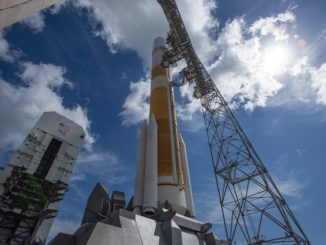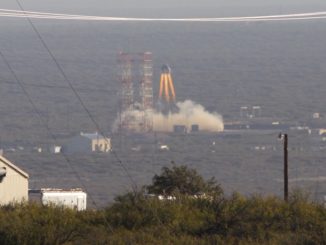A shuttle-era RS-25 rocket engine was fired at NASA’s Stennis Space Center in Mississippi on Thursday in the first test of a new engine control computer that will launch on the first flight of the agency’s Space Launch System heavy-lift rocket as soon as late next year.
The ground development engine was fired for 500 seconds inside the A-1 test stand at Stennis. Thursday’s test-firing was the first to use a controller that will be removed from the test engine and installed on one of four RS-25 engines destined to launch on the maiden SLS flight.
Developed by Honeywell and Aerojet Rocketdyne, the engine controller will relay commands between the SLS flight computer and the RS-25 engine, regulating thrust and fuel mixture ratio while monitoring the engine’s health and status, according to NASA.
Thursday’s hotfire test was conducted with Engine No. 0528, a ground article not intended for flight. It was the 12th time an RS-25 engine has been test-fired in preparation for the Space Launch System’s first flights since the test campaign began in January 2015.
Earlier test-firings used engineering models of the controller, which is about the size of a dorm room refrigerator.
NASA selected the RS-25 engines to power the core stage of the SLS because they fit the new rocket’s prescribed performance envelope and the agency already had 16 of the powerplants in stock left over from the retired space shuttle program.
But four of the RS-25 engines will fly on each SLS mission, delivering around 2 million pounds of thrust, instead of the three used on the space shuttle. The engines burn a cryogenic mixture of liquid hydrogen and liquid oxygen propellants.
“Once test data is certified, the engine controller will be removed and installed on one of four flight engines that will help power the first integrated flight of SLS and NASA’s Orion spacecraft,” NASA said in a statement.
Two solid rocket boosters, larger versions of the rocket motors that flew on the space shuttle, will provide most of the initial thrust during an SLS launch.
The RS-25 engines, which remain largely unchanged from the shuttle program besides the new controller, are being certified to operate at a higher thrust level of 109 percent, up from the 104 percent rating typically employed on the shuttle.
The first launch of NASA’s Space Launch System, expected to fly no sooner than late 2018, will send an unpiloted Orion spaceship into orbit around the moon. The space agency is studying the possibility of putting a two-person crew on the inaugural SLS flight for a round-trip journey around the moon.
Email the author.
Follow Stephen Clark on Twitter: @StephenClark1.



